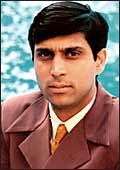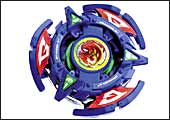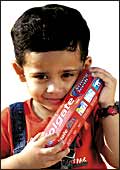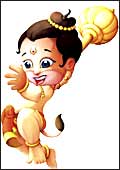|
Why
would a paint company feature two tweens wreaking havoc on their
father's blueprints in its ads? And why would a car firm do one
demanding to know whose big car her father is driving (he apparently
can't afford one) in another? At one time, the answer may have
had to do with advertising logic that dictated that no ad with
a good-looking child could ever bomb. Not today. The two ads merely
reflect a growing trend: of tweens influencing purchase decisions
in product categories not relevant to them; and of companies responding
to this by targeting the tweens. "The tween today has an
opinion on life and the colour of her room," says Piyush
Pandey, Executive Chairman and Creative Head, O&M India (that's
right, the agency made the paint ad). "Tweens are the biggest
influencers of what to eat or which mall to visit and it's the
same across the top 50 cities in India."
 |
"Tweens are the biggest influencers
of what to eat or which mall to visit and it's the same across
the top 50 cities in India"
Piyush Pandey
Executive Chairman/O&M India |
The direct market for products targeted at
tweens is an impressive Rs 20,000 crore, and growing at around
30 per cent a year. Much of this amount comes from the usual suspects:
fast moving consumer goods (FMCGs), food and beverages, and apparel.
"Kids are an important segment for us," says Amit Burman,
CEO, Dabur Foods, offering the statistic that children account
for 50 per cent of the sales of the company's Real fruit juices.
"The brand communication has to be two-pronged: it should
convince the mother about the health benefits of the product and
it should have a fun element to woo kids." Then there's the
product itself. The physical shape (or characteristic) of the
product is particularly important in the case of foods and FMCGs.
That's one reason why companies obsess over the colour of toothpaste,
magic pops that crackle when popped into the mouth, or the fruity
smell of shampoos.
Far removed from FMCGs, Riaz Patca, Director,
Ruf Apparel, also obsesses over physicality. Much of his company's
designs are influenced by Bollywood movies (all the rage among
tweens he says), and he reinforces this sure-fire strategy with
tips from his 11-year-old son on what kids his age would like
to wear.
Medium Messages
Children, especially tweens, are
the largest consumers of media and entertainment products. |
| That's a fact
staggering enough to bear repetition: kids are the biggest
consumers of media and entertainment products. Consider the
numbers: While adults spend just around two hours a day watching
television, kids are glued to the tube for over four hours
a day. And according to media analysts, they are much more
involved viewers than adults. "Ad recall among kids is
much higher than adults, simply because they are quite active
viewers as against adults who are largely becoming passive
TV consumers," says Sandip Tarkas, CEO, Media Direction.
That's a fact: most children don't just remember ads, they
even do the jingles that go with them. Not all the four hours
is spent watching the kiddie-channels. Children actually spend
more time watching Hindi movies and Hindi mass entertainment
channels (the kind that feature game shows and weepies) than
they do cartoons or other such programming targeted exclusively
at them. And some of them actually watch news channels. However,
the media habits of tweens have more to them than just TV.
Older tweens read newspapers and general interest magazines;
most tweens from higher income households surf the net; and
a significant proportion frequents multiplexes with their
parents, sometimes friends. All that adds up to a very media-savvy
consumer in the making. |
In some ways, however, categories such as
these have been supplanted by hi-tech products. Today, a tween
is likely to be far more excited by a gaming console than a new
kid-friendly toothpaste. "This is the technology generation,"
says Mohit Anand, Country Manager (Entertainment and Devices Divison),
Microsoft India. "Even children five-six years older than
current tweens have not had the exposure they do." That could
explain why the company's Windows XP business unit has chosen
to sponsor the 'Start Your Story' contest on Disney channel or
run a promotional campaign at Delhi multiplex PVR for the company's
PC games, Age of Empires 3 and Fable: The Lost Chapters to coincide
with the release of Harry Potter & The Goblet of Fire.
In such categories, tweens may play a far
larger role in the purchase decision simply because their parents
do not know as much as they do. "Children tend to have a
bigger say since they are better exposed to the capabilities of
a computer," says P. Krishnakumar, Country Manager (Consumer
Desktops), Hewlett-Packard. "Besides, there is immense peer
pressure on the (brand and configuration) of the computer owned."
That involvement extends into the consumer durable space, with
tweens offering their suggestions on the brand of tv or home theatre,
or personal digital music player to buy. One reason for that is
increasing technological complexity (an 11-year-old tween, for
instance, may know more about digital cameras than her 37-year-old
father) even in these products. Another is just that tweens (like
most other consumer segments) feel the need to be with it. "Tweens
are exerting increasing influence in the purchase of products
across all categories," says Ravinder Zutshi, Deputy Managing
Director, Samsung India Electronics, "and especially so when
there is something new and cutting-edge released in the market."
 |
 |
"This is the technology
generation. Even children five-six years older than current
tweens have not had the exposure they do"
Mohit Anand
Country Manager (Entertainment)/ Microsoft |
"Tweens are exerting
increasing influence in the purchase of products, especially
so when something new and cutting-edge is released"
Ravinder Zutshi
Deputy MD/
Samsung India |
Despite the trend of tweens being obsessed
with anything to do with consumer technology (think a gaming console
or the new iPod Video), there are some categories that have traditionally
done very well by targeting tweens (apart from other segments)
and which continue to hold their own in some cases, or just cling
on in others. Books is one such. Few tweens read; however, book
publishers (and distributors) have continued to feed off those
who do. "Children from families where the parents read still
buy books," says Anthony Joseph, coo, India Book Distributors,
adding that if tweens are not into books, it probably has more
to do with "lack of products and lack of marketing"
than the kind of backgrounds they come from. Amusement parks,
another such. Some tweens still like to visit amusement parks,
although, in India, the business is driven largely by tweens from
smaller cities, or school trips. And toys and board games, still
another. Just when it looked like traditional (think: mechanical)
toys would be overwhelmed by the digital revolution (think: gaming
consoles, pc games, and the like) came the beyblade revolution.
"Beyblades have kicked off a massive interest in the organised
toy market," gushes Daniel Selvaraj, Marketing Manager, Funskool,
a company that has an alliance with Cartoon Network to sell beyblades
in India. Then, that's a product category that is backed by all
the power of a blockbuster TV series.
-additional reporting by
Ritwik Mukherjee and Nitya Varadarajan
|









